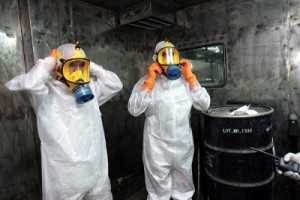
VIENNA (AP) -- Technicians upgrading Iran's main uranium enrichment facility have tripled their installations of high-tech machines that could be used in a nuclear weapons program to more than 600 in the last three months, diplomats said Wednesday.
They say the machines are not yet producing enriched uranium and some may be only partially installed. Still the move is the latest sign that 10 years of diplomatic efforts have failed to persuade Tehran to curb its uranium enrichment. Instead, Iran continues to increase its capacities.
The installations also suggest that Iran possesses both the technology and the raw materials to mass-produce centrifuges that can enrich uranium much faster than the more than 12,000 inefficient machines now making up the backbone of its enrichment program.
The Islamic Republic insists it has no interest in nuclear weapons and says it's enriching uranium only for nuclear power and other non-military applications. Iran also asserts it has a right to do so under international law.
But the United States, Israel, and their allies say Tehran's nuclear secrecy and suspicions they shared with the International Atomic Energy Agency�that Iran may have worked secretly on nuclear arms makes them fear Iran may use the technology to create weapons-level uranium that can be used in an atomic bomb.
Experts for years have suggested that the U.N. embargoes against Tehran for defying Security Council demands that it stop enrichment has left Tehran short of steel, graphite and other materials needed to make more than a few dozen prototypes of advanced centrifuges.
But the installations that began early this year and recent Iranian comments indicate the expansion has just begun.
An IAEA report in February said agency inspectors counted 180 of the advanced IR-2m centrifuges at Natanz, Tehran's main enrichment site, less than a month after Iran's Jan. 23 announcement that it would start mounting them. The report said it was unclear whether the machines were partly or completely installed.
Two diplomats who spoke to The Associated Press said while IAEA experts visiting the Iranian sites were now able to count more of the centrifuges, they remained uncertain about their operating ability because they were not permitted to get a close enough look.
One of the diplomats who spoke comes from a country critical of Iran's nuclear program while the other is considered neutral, and both spend much of their time probing Iran's nuclear activities. They demanded anonymity because they were not authorized to discuss confidential information about IAEA inspections.
The February IAEA report also said the number of other advanced centrifuge models being tested at an R&D site at Natanz separate from its enrichment plant had substantially increased to more than 300 as of February.
More recently, Iranian nuclear chief Fereidoun Abbasi was quoted Sunday by the semiofficial Fars news agency as saying more than 3,000 of the high-tech centrifuges have already been produced and will soon phase out the more than 12,000 older-generation enriching machines at Natanz.
If accurate, those numbers show that Iran has managed to outperform expectations published just two years ago. Back then David Albright of the Washington-based Institute for Science and International Security cited unnamed U.S. government sources estimating that raw-material shortages would likely limit production of the advanced machines to no more than 1,000.
Former IAEA Deputy Director General Olli Heinonen recently told the AP that Tehran could install 3,000 advanced centrifuges at Natanz within nine months from the startup date. That would mean that all of the machines Abbasi said are now ready could be put in place by October.
A phone call for reaction to Ali Asghar Soltanieh, Iran's chief IAEA representative, was not returned. The IAEA said it would have no comment.
The new IR-2ms are believed to be able to enrich two to five times faster than the outmoded machines. For nations fearing that Iran may want to make nuclear arms, that would mean a quicker way of getting there.
The up-grade reflects Iranian resistance to attempts by six nations - the United States, Russia, China, Britain, France and Germany - which are trying to persuade Iran to curb its nuclear program. The latest Iran-six power talks ended April 6 without progress in Almaty, Kazakhstan. That extended years of inconclusive negotiations and increased fears that the diplomatic window on reaching a deal on Iran's nuclear program may soon close.
Israel accuses Tehran of striving to make nuclear weapons and has threatened to bomb its atomic facilities to stop it from reaching that alleged goal if talks fail. The United States also has not ruled out such action as a last resort.
By The Associated Press
The Iran Project is not responsible for the content of quoted articles.










